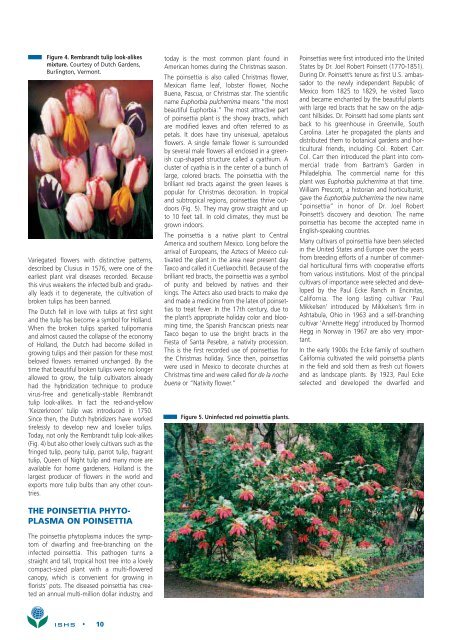Chronica - Acta Horticulturae
Chronica - Acta Horticulturae
Chronica - Acta Horticulturae
Create successful ePaper yourself
Turn your PDF publications into a flip-book with our unique Google optimized e-Paper software.
Figure 4. Rembrandt tulip look-alikes<br />
mixture. Courtesy of Dutch Gardens,<br />
Burlington, Vermont.<br />
Variegated flowers with distinctive patterns,<br />
described by Clusius in 1576, were one of the<br />
earliest plant viral diseases recorded. Because<br />
this virus weakens the infected bulb and gradually<br />
leads it to degenerate, the cultivation of<br />
broken tulips has been banned.<br />
The Dutch fell in love with tulips at first sight<br />
and the tulip has become a symbol for Holland.<br />
When the broken tulips sparked tulipomania<br />
and almost caused the collapse of the economy<br />
of Holland, the Dutch had become skilled in<br />
growing tulips and their passion for these most<br />
beloved flowers remained unchanged. By the<br />
time that beautiful broken tulips were no longer<br />
allowed to grow, the tulip cultivators already<br />
had the hybridization technique to produce<br />
virus-free and genetically-stable Rembrandt<br />
tulip look-alikes. In fact the red-and-yellow<br />
‘Keizerkroon’ tulip was introduced in 1750.<br />
Since then, the Dutch hybridizers have worked<br />
tirelessly to develop new and lovelier tulips.<br />
Today, not only the Rembrandt tulip look-alikes<br />
(Fig. 4) but also other lovely cultivars such as the<br />
fringed tulip, peony tulip, parrot tulip, fragrant<br />
tulip, Queen of Night tulip and many more are<br />
available for home gardeners. Holland is the<br />
largest producer of flowers in the world and<br />
exports more tulip bulbs than any other countries.<br />
THE POINSETTIA PHYTO-<br />
PLASMA ON POINSETTIA<br />
The poinsettia phytoplasma induces the symptom<br />
of dwarfing and free-branching on the<br />
infected poinsettia. This pathogen turns a<br />
straight and tall, tropical host tree into a lovely<br />
compact-sized plant with a multi-flowered<br />
canopy, which is convenient for growing in<br />
florists’ pots. The diseased poinsettia has created<br />
an annual multi-million dollar industry, and<br />
today is the most common plant found in<br />
American homes during the Christmas season.<br />
The poinsettia is also called Christmas flower,<br />
Mexican flame leaf, lobster flower, Noche<br />
Buena, Pascua, or Christmas star. The scientific<br />
name Euphorbia pulcherrima means “the most<br />
beautiful Euphorbia.” The most attractive part<br />
of poinsettia plant is the showy bracts, which<br />
are modified leaves and often referred to as<br />
petals. It does have tiny unisexual, apetalous<br />
flowers. A single female flower is surrounded<br />
by several male flowers all enclosed in a greenish<br />
cup-shaped structure called a cyathium. A<br />
cluster of cyathia is in the center of a bunch of<br />
large, colored bracts. The poinsettia with the<br />
brilliant red bracts against the green leaves is<br />
popular for Christmas decoration. In tropical<br />
and subtropical regions, poinsettias thrive outdoors<br />
(Fig. 5). They may grow straight and up<br />
to 10 feet tall. In cold climates, they must be<br />
grown indoors.<br />
The poinsettia is a native plant to Central<br />
America and southern Mexico. Long before the<br />
arrival of Europeans, the Aztecs of Mexico cultivated<br />
the plant in the area near present day<br />
Taxco and called it Cuetlaxochitl. Because of the<br />
brilliant red bracts, the poinsettia was a symbol<br />
of purity and beloved by natives and their<br />
kings. The Aztecs also used bracts to make dye<br />
and made a medicine from the latex of poinsettias<br />
to treat fever. In the 17th century, due to<br />
the plant’s appropriate holiday color and blooming<br />
time, the Spanish Franciscan priests near<br />
Taxco began to use the bright bracts in the<br />
Fiesta of Santa Pesebre, a nativity procession.<br />
This is the first recorded use of poinsettias for<br />
the Christmas holiday. Since then, poinsettias<br />
were used in Mexico to decorate churches at<br />
Christmas time and were called flor de la noche<br />
buena or “Nativity flower.”<br />
Figure 5. Uninfected red poinsettia plants.<br />
Poinsettias were first introduced into the United<br />
States by Dr. Joel Robert Poinsett (1770-1851).<br />
During Dr. Poinsett’s tenure as first U.S. ambassador<br />
to the newly independent Republic of<br />
Mexico from 1825 to 1829, he visited Taxco<br />
and became enchanted by the beautiful plants<br />
with large red bracts that he saw on the adjacent<br />
hillsides. Dr. Poinsett had some plants sent<br />
back to his greenhouse in Greenville, South<br />
Carolina. Later he propagated the plants and<br />
distributed them to botanical gardens and horticultural<br />
friends, including Col. Robert Carr.<br />
Col. Carr then introduced the plant into commercial<br />
trade from Bartram’s Garden in<br />
Philadelphia. The commercial name for this<br />
plant was Euphorbia pulcherrima at that time.<br />
William Prescott, a historian and horticulturist,<br />
gave the Euphorbia pulcherrima the new name<br />
“poinsettia” in honor of Dr. Joel Robert<br />
Poinsett’s discovery and devotion. The name<br />
poinsettia has become the accepted name in<br />
English-speaking countries.<br />
Many cultivars of poinsettia have been selected<br />
in the United States and Europe over the years<br />
from breeding efforts of a number of commercial<br />
horticultural firms with cooperative efforts<br />
from various institutions. Most of the principal<br />
cultivars of importance were selected and developed<br />
by the Paul Ecke Ranch in Encinitas,<br />
California. The long lasting cultivar ‘Paul<br />
Mikkelsen’ introduced by Mikkelsen’s firm in<br />
Ashtabula, Ohio in 1963 and a self-branching<br />
cultivar ‘Annette Hegg’ introduced by Thormod<br />
Hegg in Norway in 1967 are also very important.<br />
In the early 1900s the Ecke family of southern<br />
California cultivated the wild poinsettia plants<br />
in the field and sold them as fresh cut flowers<br />
and as landscape plants. By 1923, Paul Ecke<br />
selected and developed the dwarfed and<br />
ISHS • 10
















